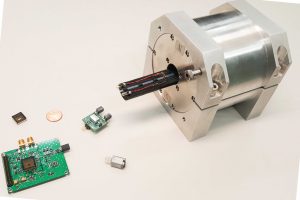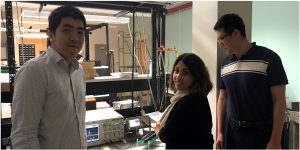The University of Macau (UM) and Harvard University have developed a portable nuclear magnetic resonance (NMR) platform by using advanced integrated circuits technology. The platform not only can significantly improve the efficiency and effectiveness of NMR tests; it can also be applied in biological diagnostic tests. For instance, conducting blood and protein tests with this platform is much cheaper and faster than using the traditional NMR testing method.
The UM researcher that worked with the research team at Harvard University is Dr Lei Ka-Meng of the Institute of Microelectronics. In 2017, Dr Lei was invited to serve as a postdoctoral visiting scholar at Harvard University for a two-year term. During his stay at Harvard University, Dr Lei carried out interdisciplinary research with faculty members of the Harvard School of Engineering and Applied Sciences and Department of Physics in an effort to improve the older version of the NMR platform to enable more effective application of the platform in different fields (such as for testing the concentration of protein, molecular structure, and the ingredients of food samples). ‘One member of the interdisciplinary research team is a scientific advisor at Schlumberger, the world’s leading oilfield service provider, and through working with him, I gained a better understanding of the merits and drawbacks of the old version of the platform and was able to improve it,’ says Dr Lei.
This portable NMR platform consists of semiconductor chips and portable magnets for NMR testing. Thanks to proposed parallelism for portable NMR which reduces experimental time, this platform can be used to perform fast testing of biological and chemical samples (such as DNA and protein samples), thereby significantly reducing the cost and time of the tests. ‘The current diagnostic tests usually require the use of large devices and a lot of time and skilled professionals, but with the proposed NMR technique, we no longer need to use large devices for diagnostic tests and the cost can be brought down from between MOP 500,000 and MOP 600,000 to between MOP 30,000 and MOP 40,000,’Dr Lei explains. ‘Moreover, this technique allows diagnostic tests to be conducted outside the centralised laboratory. Even clinics in remote regions can afford it. I really hope this technique will be introduced to other parts of the world.’
Dr Lei was born and raised in Macao. He received his bachelor’s degree in electrical and electronics engineering from UM in 2012, and he was among the first cohort to graduate from UM’s Honours College. He began to participate in challenging research projects of the State-Key Laboratory of Analog and Mixed-Signal VLSI in his third year of undergraduate studies. Because of his outstanding research capability, after receiving his bachelor’s degree he was directly admitted for PhD studies at UM, under the joint supervision of the laboratory’s deputy director Prof Mak Pui In and associate professor Law Man Kay. In 2017, he received the prestigious Predoctoral Achievement Award from the Solid-State Circuits Society of the Institute of Electrical and Electronics Engineers.
Source: Institute of Microelectronics
Media Contact Information: Communications Office, University of Macau
Albee Lei Tel:(853) 88228004Kelvin U Tel:(853) 88224322Email:prs.media@um.edu.moUM Website:www.um.edu.mo


